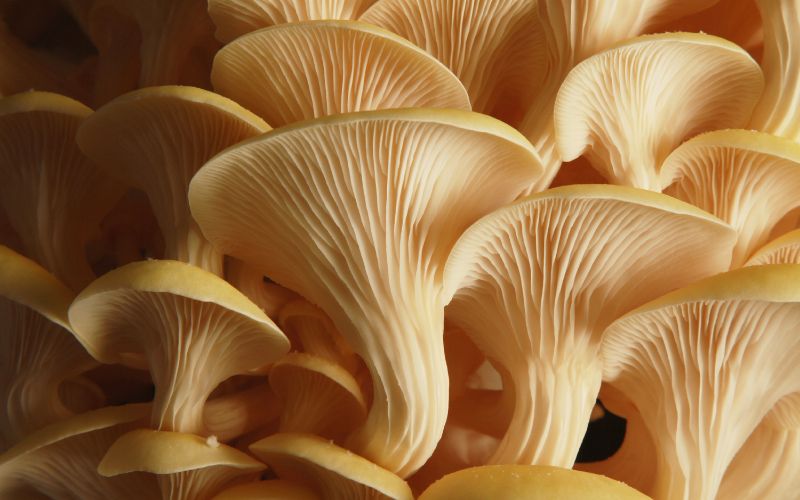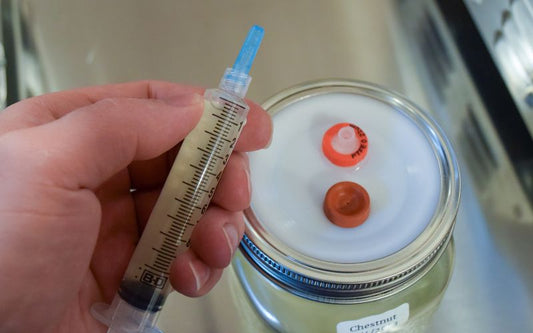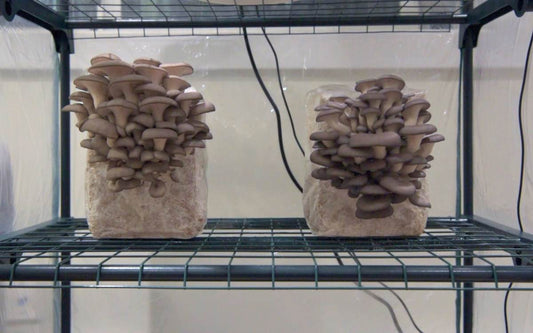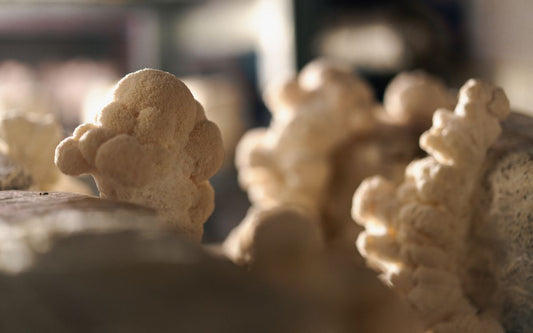In Western society, when someone says "mushroom," they're typically referring to button mushrooms.
But there are so many other kinds of tasty (not to mention medicinal) mushrooms out there, including the humble oyster mushroom.

In this guide, we'll cover everything you need to know about oyster mushrooms, from cooking methods to growing your own at home.
What are oyster mushrooms?
Oyster mushrooms are a type of edible mushroom that grow in temperate and subtropical forests around the world.
They are named oyster mushrooms because they resemble oysters with their fan-like shape.

Oyster mushrooms come in a variety of species that feature unique colours, including white, yellow, pink, blue, grey, and black.
They are easy and inexpensive to grow, making them a popular mushroom to cultivate commercially and at home.
What do oyster mushrooms taste like?
Generally, oyster mushrooms have a meaty texture with a mild yet savoury taste.
Though, depending on the type of oyster mushroom, taste can vary.
For example, pink oyster mushrooms are often said to taste like bacon, while yellow oyster mushrooms have a hint of citrus!
Should I cook oyster mushrooms?
Oyster mushrooms should always be cooked before eating.
Cooking oyster mushrooms not only brings out the flavour of the mushroom, but also makes them easier to digest.

Mushrooms contain chitin, a fibrous material that is indigestible to humans.
When oyster mushrooms are cooked, the chitin breaks down, making them possible to eat without discomfort.
Cooking with oyster mushrooms
Oyster mushrooms can be cooked in a variety of ways.
They are commonly stir-fried, sautéed, deep fried, or added to soups and stews.
To avoid overcooking your mushrooms, add them towards the end of the cooking process.
Oyster mushrooms can also be dried and rehydrated before use in soups and stews.

At Folk Fungi, we love pan fried oyster mushrooms.
Check out this simple but tasty recipe: Garlic Butter Oyster Mushrooms.
If you're on a plant-based diet, sub out butter for olive oil.
They also go great with soy sauce.
Where can I buy oyster mushrooms?
Cultivated oyster mushrooms are widely available at grocery stores.
If you can't find them in a store, check out a local farmer's market.
Or you can always grow your own!
How should I store oyster mushrooms?
Fresh oyster mushrooms should be refrigerated in a paper bag.
Avoid washing them before storing, as this can cause the mushrooms to spoil more quickly.
If stored properly, oyster mushrooms will keep for up to one week.
Dried oyster mushrooms should be stored in an airtight container in a cool, dry area.
Where can I find wild oyster mushrooms?
Wild oyster mushrooms can be found growing in temperate and subtropical deciduous forests, particularly on dead hardwood trees like oak or beech trees.
It's important to note that oyster mushrooms are easily confused with other poisonous look-alikes, including some deadly varieties.

When looking for these mushrooms, going with an experienced guide is always the best bet.
Also, if you're interested in foraging oyster mushrooms, be sure to double-check the laws in your area before taking any from the wild.
Are oyster mushrooms good for you?
Oyster mushrooms are a great source of nutrition.
They contain high levels of many vitamins and minerals, including vitamin B2 (riboflavin) and vitamin D.
Oyster mushrooms are also rich in dietary fibre and plant-based proteins, which make them a great meatless option for those following vegetarian or vegan diets.
What are the health benefits of oyster mushrooms?
Oyster mushrooms have been linked to a number of health benefits, including immune system support, blood sugar regulation, and reduced inflammation.
They are also a good source of antioxidants, which help protect the body from damage caused by free radicals.

In addition, oyster mushrooms contain compounds that may even have cancer-fighting properties as well as anti-viral and anti-microbial effects (further research is still needed).
The different types of oyster mushrooms
As mentioned earlier, oyster mushrooms come in a variety of species. We've highlighted a few of the most common species below.
Pearl oyster mushrooms (Pleurotus ostreatus)
Also known as the "common oyster mushroom," this is the kind most commonly found in grocery stores.
It's known for its grey colour and mild flavour.

Blue oyster mushrooms (Pleurotus ostreatus var. columinus)
A cold-weather mushroom, the blue oyster has a bluish to grey hue and a sweet, delicate flavour.
When grown outdoors, these mushrooms tend to have a dark blue hue.
When grown indoors, they are often more grey than blue.

Pink oyster mushrooms (Pleurotus djamour)
A tropical mushroom, the pink oyster mushroom thrives in warm temperatures.
It's a popular species, due to its bacon-like flavour and beautiful colour.
However, pink oysters don't have a long shelf-life.
They typically need to be eaten within 48 hours of harvesting.

Yellow oyster mushrooms (Pleurotus citrinopileatus)
Like pink oysters, yellow oysters need warm temperatures to grow.
Taste-wise, they offer a balanced, nutty flavour with a hint of citrus.
Their vibrant yellow colour makes them a great visual addition to any dish.

King oyster mushrooms (Pleurotus eryngii)
The largest oyster mushroom species, the king oyster has a thick stem and an earthy flavour.
A popular substitute for meat due to its thickness, king oysters are often served grilled, sautéed, or roasted.

Other oyster mushrooms
Above, we covered the most common types of oyster mushrooms, especially when it comes to cultivated oyster mushrooms.
But there are over 200 kinds of Pleurotus mushrooms out there!
Many of them are not commonly cultivated and are only found in the wild.
Can I grow oyster mushrooms at home?
Yes, you can grow oyster mushrooms at home!
Oyster mushroom are one of the easiest (if not the easiest) mushroom to grow, which is partly why they are so popular.
The easiest way to get started: a mushroom grow kit.

A kit includes everything you need to grow several crops of mushrooms, no experience necessary.
Also, if you're willing to put in a bit more effort and time, you can grow oyster mushrooms by purchasing oyster mushroom spawn.
Spawn is mycelium (the root-like system of mushrooms) grown on grain.
You can add spawn to a substrate (from hardwood to coffee grounds), which will eventually fruit mushrooms given the right conditions.
Below, we'll cover both methods.
Growing oyster mushrooms with a kit
A typical kit includes two main components you'll need to grow mushrooms: a fruiting block (a plastic bag containing hardwood sawdust and oyster mushroom mycelium) and a spray bottle.
Step 1: Cut an "X" into the plastic bag of the fruiting block and place it somewhere that receives indirect sunlight.
(Direct sunlight can stunt the growth of your mushrooms.)
Step 2: Mist the block with your spray bottle every day to create a humid environment.
Within 5 to 10 days, little oyster mushrooms will appear from the "X."

The little mushrooms, called "pins," will grow to full size within four to seven days after initial growth.
From start to finish, it takes about two weeks to grow oyster mushrooms from a kit.
Remember: different oyster mushrooms need different temperatures to thrive.
If you live in a cold climate and your home gets a bit chilly at night, avoid warm weather species like pink or yellow oyster mushrooms.
The nice thing about oysters is that most species grow just fine at room temperature.
Growing oyster mushrooms with grain spawn
If you're feeling up to a little more of a challenge, you can also grow oyster mushrooms using grain spawn.
The process can become a bit complex, so we won't into a ton of detail here, but here's a brief overview so you understand the basics.
As mentioned earlier, grain spawn is mycelium growing on grain.
To use oyster spawn, add it to a suitable substrate (oysters love hardwood sawdust), which needs to be hydrated for the mycelium to grow and sterilized to eliminate potential contaminants.

The substrate/spawn mix also needs to be added to a growing container, like a mushroom grow bag, creating a fruiting block.
The mycelium will expand from the grain to the substrate, eventually taking it over completely (this process is called colonization).
After two to three weeks, the fruiting block will be fully colonized.
With the right conditions (mainly high humidity and a bit of indirect sunlight), the fruiting block will fruit mushrooms.
A mushroom kit comes with a single fruiting block, but you can make six to eight fruiting blocks with a bag of spawn that costs about the same as a mushroom kit.
Though, you'll also need to buy hardwood sawdust and the other necessary equipment.
If you've never grown mushrooms before, we suggest starting with a kit.
If you've tried a kit and want to take your growing to the next level, using spawn to make fruiting blocks is a great choice.
Can you grow oyster mushrooms on coffee grounds?
Oyster mushrooms love coffee grounds!
Though, coffee grounds need to be supplemented with other ingredients (such as hardwood sawdust) for oyster mushrooms to truly thrive.

Your oysters won't fruit as much and as quickly as they would on a straight hardwood substrate, but you can still get a decent crop from coffee grounds.
Benefits of growing your own oyster mushrooms
The number one benefit: having a fresh supply of oyster mushrooms!
Oyster mushrooms only have a seven-day shelf life, which means the ones in the grocery store are definitely not fresh.
Plus, oyster mushrooms can be grown indoors with just a little bit of space, so if you don't have a garden or backyard, you can still grow your own food.
Finally, oysters are easy to cook with, so growing your own gives you the opportunity to incorporate them into delicious and healthy meals.
Conclusion: Should I try oyster mushrooms?
Oyster mushrooms are a nutritious addition to any meal.
They are also easy to grow at home, making them a great choice for the beginning mushroom grower.
Health-conscious individuals will be happy to know that oyster mushrooms have many potential health benefits.
If you're looking for a new food to add to your diet or wanting to start your own personal mushroom farm, oyster mushrooms are an excellent choice.

Spenser Smith
I am passionate about mushrooms. My number one goal: help you grow mushrooms in your home!




